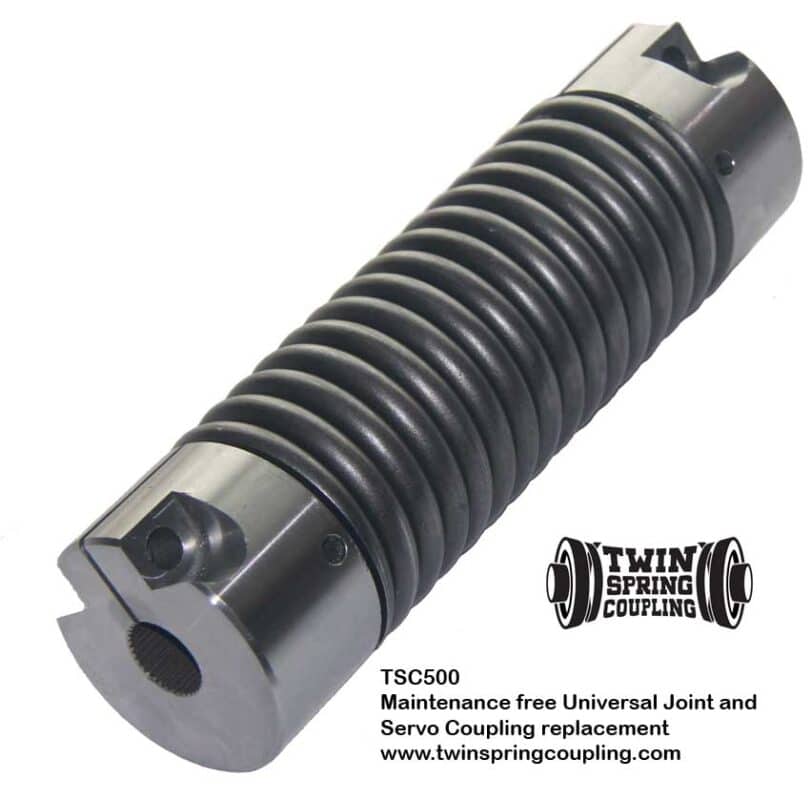The true cost of universal joints are not so simple, a low initial price but with ongoing maintenance means it becomes a lot more expensive
Table of Contents
Lets face it, its an old technology, 115 years old to be exact, the first use of the word by inventor Robert Hooke in 1676 shows the coupling is far older.
The Spicer uni joint of 115 years ago was patented by Clarence Spicer, and the same technology is still in use today.
The limitations of the universal joint regardless of what brand – Spicer, Lovejoy, SKF, Neapco they are all the same, they are made up of 3 components – 2 end yokes and the universal joint itself.
Each of these components have their own weaknesses and maintenance concerns that have to be attended to otherwise you end up with coupling failure or equipment damage.
So what is the true cost of universal joints?
Universal Joints –
The uni joint itself has 4 bearings, each of these small bearings are self contained but each of these bearings MUST be lubricated or the bearing will overheat and seize requiring replacement. So the universal joint itself has a grease nipple or zerk to allow grease to be administered to these bearings.
This means a maintenance plan must be put in place to ensure this greasing is constantly done, this means labor to do the greasing, downtime of the machinery to allow the greasing to be done and the cost of materials as well.
In addition to the greasing is the actual lifespan of the bearings themselves, as with use they do wear and need to be replaced. The angle at which the universal joint is used also dictates when it needs to be replaced. The angle of usage means the ball bearings inside the bearings are forced against the edge of the “race” or the groove the ball bearings sit inside.
The larger the angle of usage means the more the ball bearings wear the outside edge of the race, making the ball bearings loose inside the race which leads to increased vibration. This vibration leads to equipment damage and at the worst bearing failure.
Yokes –
Each uni joint is attached to a pair of Yokes, one for input and one for the output. Most times the yokes are different both ends to accommodate different input/output shafts. The yokes are attached to the bearings of the universal joint which makes it a source of stress especially when the universal joint is used at higher angles of misalignment.
The yokes while quite substantial in size at the shaft ends, but not where the uni joint is inserted into it, they are not much larger than the bearings themselves, which makes it a weak point and a place where cracking and failure occurs. This means the yoke has to be replaced.
Once again that means labor to replace the yoke, the actual time to, in some cases cut the yoke off the shaft and then the replacement has to be welded on. This potentially means increased downtime to get the correct replacement yoke, if not available.
This becomes of bigger concern if the uni joint is not made by one of the large multinationals, like Spicer, Lovejoy, GKN, SKF, Ruland, Belden then the ability to get a replacement yoke could prove impossible to obtain.
When you add the universal joints and then the yokes together as a coupling solution it shows that while its a time tested flexible coupling it is also not without its drawbacks. These same drawbacks when it comes to constant maintenance (either planned or unplanned) downtime (for maintenance or replacement due to product failure) and replacement of components (universal joint bearings or yokes).
This means that design engineers have had to change their designs to accommodate for these drawbacks as well as the actual use of the couplings in the day to day operation of the equipment (usage angle, speed, environment it runs in, HP required)
Our one piece design means we can offer you a product where most of these drawbacks don’t exist, no bearings so no greasing or worn replacement, no yokes just 2 integrated hubs with the required shaft splines so no broken yokes.
Our twin spring design means its more flexible than a uni joint and is able to handle far rougher treatment (no broken bearings or yokes to content with).
As the traditional coupling of choice, when there was no other option, you had to put up with the associated labor, maintenance and downtime costs. Not any more, check out out how we can help you
https://twinspringcoupling.com/coupling-products/

